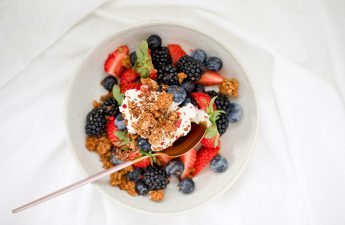
Living more sustainably doesn’t have to be a substantial time – or money – drain. So if Earth Day this week puts you in the mood to rethink how items get used in the kitchen, these eco-conscious choices might actually save you some cash over time:
- Proper food storage: If you frequently have to chuck moldy cheese or meat covered in icicles, check what temps your fridge and freezer are set to. According to the U.S. Food and Drug Administration (FDA), “The temperature of your fridge should be at 40° F or below to keep foods safe. And the freezer should be 0° F.” Other tips include leaving fruits like avocados, pears, mangoes and bananas on the counter until they ripen (then consume or freeze), plus placing a paper towel into air-tight containers with fresh spinach or a salad mix to absorb excess moisture.
- Minimize Food Waste: A study conducted by The Center for Biological Diversity reported, “About 40 percent of the food produced in the United States goes uneaten.” One of the most effective ways to decrease the amount of food you toss out is to pre-plan meals one to two weeks in advance. Afterward, stick to buying your recipe ingredients while grocery shopping to avoid stocking up on fresh food that won’t get used before it starts to rot.
- Compost: Reduce your carbon footprint by turning coffee grounds, leftovers and inedible peels into organic matter that can be used as low-key fertilizer in flower beds and vegetable gardens—a.k.a. DIY plant food. Repurposing food waste in this capacity means less biodegradable substances end up in landfills smooshed between other materials which will never decompose.
Have an eco-friendly kitchen habit that has also saved you some coin over the years? Share your tip in the comment box.
Greet the world with a warm smile this Wednesday!
—Rachel



I am pretty fanatical about not wasting food! I always plan meals around the fresh produce that needs to be eaten first. I also freeze fruits, vegetables, and any leftovers that I think we won’t eat within 2 days. I keep a running list of what’s in the freezer and what order that needs to be eaten in too. Thank you for sharing your tips!
Robin,
I REALLY like the idea of keeping a list of what’s in the freezer and waiting to be used. I may start doing this as well.
I agree with Robin! This information from Rachel was very helpful to read. I had never heard of using those temperatures specifically with my fridge and freezer and did have lots of ice forming on foods in the freezer! Also so important was the point to “not waste food”! We all try but this is hard when foods go bad before we use them….great tips Rachel and I hope as Earth Day approaches others will read and put into practice your shared information! Think of doing what you can to put the world in good shape for our grandchildren!
Very glad to hear you found this week’s blog to be so useful, Joan!
While it may not be convenient for us, shopping more often and buying less each time helps us to eat what’s on hand. French shoppers go shopping 2-3 times a week and buy fresh items that will be eaten quickly instead of storing them in the fridge for a week or more.
Hi Kelly,
Like you, I usually head to our local food co-op or another grocer multiple times a week. There’s a big preference for fresh, locally made bread in my house. Plus I frequently have a new recipe I want to try that necessitates another mini-shopping trip as well.
We needed hot water for dishes. I run the cold water into a jug until I hit the temperature I need. I use the jug water for dog dish, coffee pot, water flowers etc. it saves my septic from extra water too.
Stellar tip, Sharon! So smart & would be simple to implement for many folks.
Great idea Sharon, I’ll save the water for my cats and houseplants!
I boil eggs every week for handy snacks and meals. I then save the calcium rich water for my houseplants and in summer, my herbs.
This is another superb water “reuse” tip, Pat!
To minimize waste, I make soup. I keep a gallon-size plastic container in the freezer for that purpose. Little dabs of leftovers go in, and i drain cans of vegetables into it. Produce that’s past its prime goes in, & even wilted salad greens. When the container is full, I make soup, adding meat, vegetables, and seasonings as needed. It’s always different, but always good.
May,
I often use fresh veggies that are “going off” in a similar capacity (because I eat soup A LOT). But, I hadn’t thought of “stockpiling” smaller amounts in the freezer to use once I have large enough quantity to make a full pot later. So THANKS for sharing this idea.
Rachel awesome article
Appreciate the feedback, Tamson!